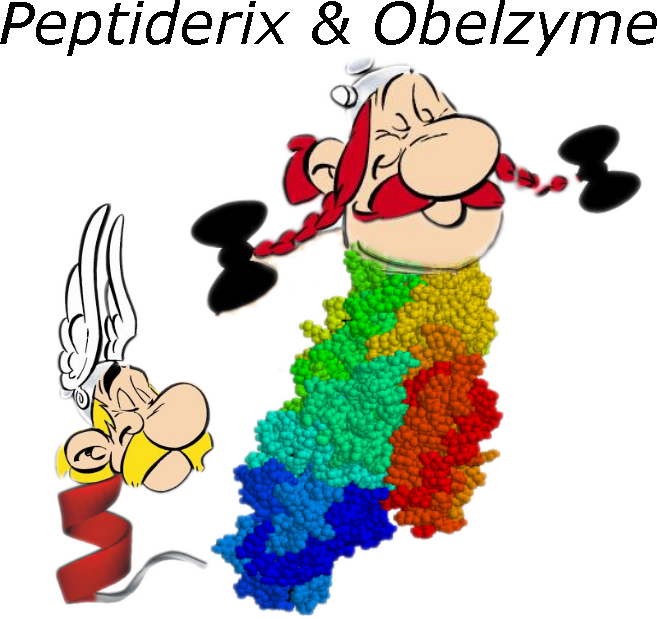Team:Imperial College London/M1
From 2009.igem.org
JamesField (Talk | contribs) (→40px Module 1 Overview) |
JamesField (Talk | contribs) (→40px Module 1 Overview) |
||
| Line 15: | Line 15: | ||
Polypeptides are classified according to their size and functional properties. Peptides are short chains of amino acids that often play a role in signalling and enzyme inhibition. At the other end of the spectrum, we have enzymes which are typically much larger with complex three dimensional structures. Enzymes serve to accelerate the rate at which chemical reactions occur in the cell. | Polypeptides are classified according to their size and functional properties. Peptides are short chains of amino acids that often play a role in signalling and enzyme inhibition. At the other end of the spectrum, we have enzymes which are typically much larger with complex three dimensional structures. Enzymes serve to accelerate the rate at which chemical reactions occur in the cell. | ||
| - | + | To demonstrate <b><i>The E.ncapsulator's</i></b> versatility, we have chosen to showcase it with both enzymes and peptides. These two classes of polypeptide have very different properties that we have considered and catered for in <b><i>The E.ncapsulator's</i></b> design. | |
Revision as of 07:45, 16 September 2009

Contents |
 Module 1 Overview
Module 1 Overview
The E.ncapsulator has been designed to produce and deliver polypeptides (amino acid polymers) to the intestine. Module 1 encompasses the polypeptide production phase. During this period, our polypeptide of interest is synthesised at a rate sufficient to faciliate its accumulation inside the cell.
Polypeptides are classified according to their size and functional properties. Peptides are short chains of amino acids that often play a role in signalling and enzyme inhibition. At the other end of the spectrum, we have enzymes which are typically much larger with complex three dimensional structures. Enzymes serve to accelerate the rate at which chemical reactions occur in the cell.
To demonstrate The E.ncapsulator's versatility, we have chosen to showcase it with both enzymes and peptides. These two classes of polypeptide have very different properties that we have considered and catered for in The E.ncapsulator's design.
Peptide Delivery
While a few peptide drugs can be taken orally, many are suseptible to breakdown in the stomach making them suitable candidates for encapsulation. To achieve peptide compatibilty, it was necessary to equip The E.ncapsulator with a special mechanism that facilaites peptide synthesis.
Polypeptide synthesis ALWAYS begins with the amino acid methionine. However, polypeptides are often chopped up in a controlled manner to produce smaller functional peptides. These functional peptides often do not begin with the amino acid methionine. To produce peptides without inhibiting their functionality, we have developed a removable linker region that starts with the amino acid methionine. Following the release of the peptide in the intestine, a naturally occuring protease removes the linker region from the front of the peptide releasing the remainder in its functional form. This linker region can be used to faciliate the synthesis of every polypeptide that does not begin with methionine.
To showcase peptide delivery, we have chosen the pentapeptide (five amino acids)+++++++++. This represents the first iGEM entry to provide a treatment for pain, arousal and depression.
Enzyme Delivery
Enzymes = acid protection for 3d conformation
- Protein value = PAH = metabolic subcontraction from liver. Treatment for a genetic disease.
- Innovation = SDR for protease resistance
- Protein value = Cellulase = increase microbiome functionality
Although The E.ncapsulator is designed to be versatile with regard to which protein is to be produced, we have chosen two enzymes as demonstration, phenylalanine hydroxylase and cellulase.
Cellulase

Cellulose is a compound that is abundant in the human diet - it is what is commonly referred to as 'dietary fibre.' However, the human body is unable to degrade cellulose into glucose naturally, as it lacks the enzymes required to break down this fibrous material.
Cellulase is an enzyme that breaks down cellulose to glucose. By engineering The E.ncapsulator to produce this enzyme and delivering it to the small intestine, we would give the consumer the ability to digest dietary fibre. This would allow more energy and nutrients to be extracted from food; that which was previously unavailable.
More information on cellulase can be found here
Phenylalanine Hydroxylase
Phenylketonuria is a digestive disorder caused by an inability of the body to break down the amino acid phenylalanine. The amino acid accumulates in the blood, and can cause serious health problems for afflicted individuals. Current treatments for the condition revolve around following a strict very low protein diet.
Phenylalanine Hydroxylase (PAH) is an enzyme that breaks down the amino acid phenylalanine into tyrosine. By introducing this enzyme into the digestive system with The E.ncapsulator's unique drug delivery mechanism, we hope to treat the sufferers of PKU.
To find out more about phenylketonuria and PAH, click here.


| Next > Module 1: Genetic circuit |
 "
"






